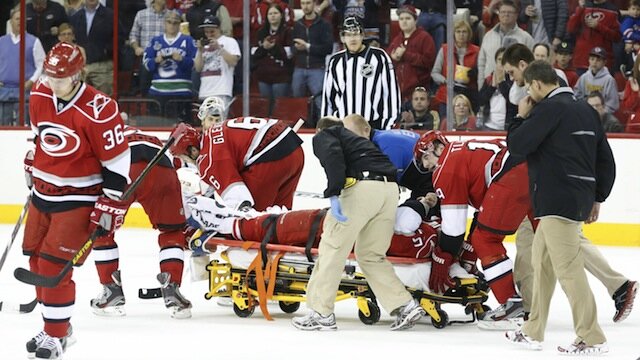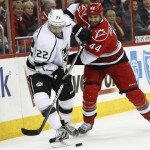Icing, along with offsides and the power play, is without a doubt the hardest of the rules and nuances in hockey to explain to new fans of the NHL. To be fair, Icing is a little complicated. Even the seasoned fans often times will have to look at the linesman’s arm to tell when icing is coming.
It’s a handy rule that keeps the game speed moving at a non-boring level and forces teams to play actual defense. It is not without its flaws, as the “foot race” part of the rule has been called into question.
Related: Carolina Hurricanes Need More Defense In Front Of Cam Ward
After Carolina Hurricanes defenseman Joni Pitkanen went down last season with a fractured heel in an icing foot race, the league had reached a tipping point where they were forced to reexamine the icing rule and how it’s enforced.
Most analysts and observers were saying it was finally time for “no touch” icing. This is the version used in international play and the Olympics, where the offensive player does not have to touch up in the zone and the officials whistle the infraction once the puck crosses the end line unopposed.
Critics of this will insist that allowing a defensive player to beat out an icing call and keep the play alive brings out an element of excitement to the game. Pitkanen and the Hurricanes would not agree.
While the icing rule worked in the earlier days of the league, what the “we’ve always done it this way” crowd forgets is that skates, protective gear, and anything else attached to players have become exponentially more advanced, lightweight and ergonomically “permissive”. Players are skating faster and hitting harder. While a foot race would have been exciting to see in the late 1960s, in 2013 it’s flat out unsafe.
The NHL’s answer this season has been a system of “hybrid icing”, where the decision to whistle a play dead or to force a player to touch up is left up to the officials. The decision is made based on a list of criteria that are too subjective, complex, and stupid to repeat. The only thing that needs to be said is that it is left to the official’s discretion.
Rarely has anything been “left to the official’s discretion” that ended well.
If the needless “diving” penalty has taught us anything, it’s that allowing any level of subjectivity to when or why a rule is to be enforced is bad for the game. Officials need to use judgement, but that judgement needs to be used to decide when a rule with clear cut definitions has been violated. Nothing else. Did a player’s free hand come up, warranting a roughing call? These are things an official’s judgement is made for, not whether or not a rule applies, or when it does or doesn’t.
While the NHL insists on making fighting the marquee safety issue, it is a shame that another awful incident like Pitkanen’s injury, or worse, will have to happen before “no touch icing” becomes the standard in the world’s premier league.
Hybrid icing is a mistake, and someone will have to pay for this mistake with their safety.
Michael Peckerar is a Hurricanes writer for www.RantSports.com. Follow him on Twitter @peckrants, “Like” him on Facebook or add him to your network on Google

















